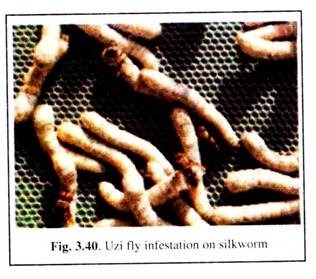In this article we will discuss about Uzi Fly:- 1. Modes of Transmission of Uzi Fly 2. Symptoms of Infestations of Uzi Fly 3. Control Measures.
Modes of Transmission of Uzi Fly:
The female Uzi fly oviposits the eggs singly on the inter-segmental membrane or among the bristles of body surface of III or IV or V instar (Fig. 3.40). Following 2-3 days of oviposition, the fusiform, legless maggot penetrates into the host body by making a hole on the cuticle. It forms a conical tube-like chamber, where it resides and grows by taking nearby fat tissues of the host and respiring aerobically.
Later, it leaves that chamber and starts to take internal tissues of the host and respires anaerobically. After III maggot stages, the full grown maggot comes out of host body and pupates in nearby soil or crevices and cracks.
Symptoms of Infestations of Uzi Fly:
(i) Uzi maggot-infected silkworm shows black spots on their body surface at the place of maggot entry;
ADVERTISEMENTS:
(ii) Loss of weight due to continuous loss of fat bodies and other tissues;
(iii) Stop feeding;
(iv) Proneness to other bacterial or viral infections, and
ADVERTISEMENTS:
(v) Sluggish movement.
Control Measures of Uzi Fly:
(i) Prevention of Uzi Fly Entry in the Rearing Room:
Use of uzinet (nylon net of fine mesh) all around the rearing shelf stand and on windows of rearing room. Fly leaf paper coated with vaseline or insecticide on window can also be used to trap the flies.
(ii) Destruction of Uzi-Eggs:
ADVERTISEMENTS:
‘Uzicide’ (formulated by CSR & TI, Mysore) or Vijeta (formulated by CSR & TI, Berhampore), can be spread on rearing tray that kills the Uzi-eggs without affecting the silkworm growth. Besides, bleaching powder is also found to deter Uzi fly from egg laying.
(iii) Control of Uzi Fly Population:
Reproductive potential of adult Uzi fly can be reduced by releasing radiation-exposed sterile fly in the field, which would produce less viable eggs following mating with normal or other such fly. Chemoste-rilants like 10% dimilin, if applied topically on Uzi fly larvae can reduce the number of eggs laid by that adult flies.
(iv) Biological Control:
Of Uzi fly population includes release of natural predators like spiders in the field and some hymenopteral pupal parasites of Uzi fly like Nesolynx thymus, Dirhinus himalayanus, Spilomicrus karnatakensi, etc. Hymenopteran if cultured and released in Uzi affected area, they pupate inside the Uzi puparia and kill it while the adult parasites emerge.
To prevent Uzi larvae to complete metamorphosis, Uzi larvae, pupae found in rearing room should be collected and killed by putting in hot water. No cracks and crevices should be left in rearing room that may allow pupation of the parasitic fly. Besides, transportation of larvae, cocoon of silk moth from Uzi infested area should be avoided.
